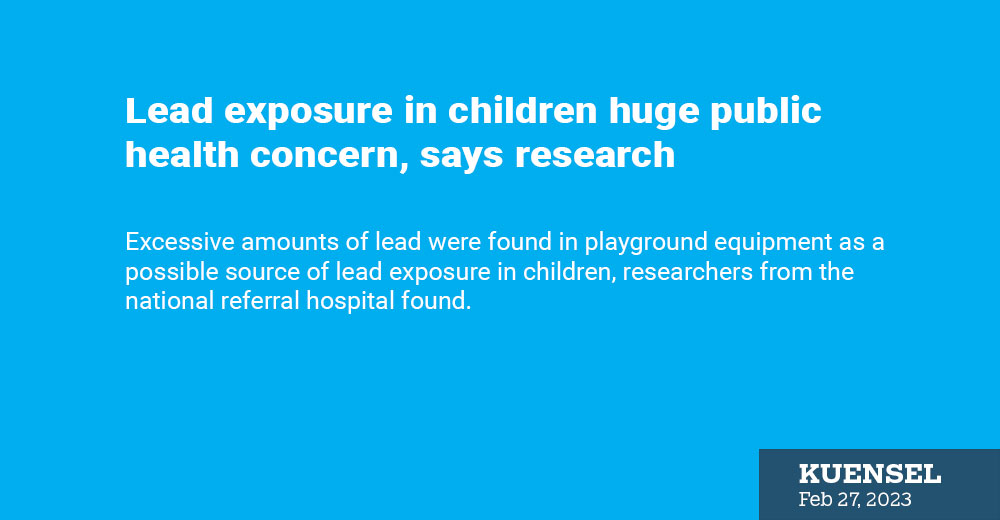… Public playgrounds have been identified as a possible source of lead exposure
Lhakpa Quendren
Excessive amounts of lead were found in playground equipment as a possible source of lead exposure in children, researchers from the national referral hospital found.
According to the recent study by a group of nurses from the JDWNRH, more sources are likely still present and not yet identified. “Infants and children are exposed to lead through various sources in the environment.”
In the first pediatric blood-lead study in Thimphu and Phuentsholing, 44 percent of children aged two to 60 months had dangerously high levels of lead.
According to the JDWNRH researchers, infants and children are at very high risk because they often put their fingers, toys, or other objects in their mouths. “When lead is present in the environment, this behaviour results in direct ingestion of lead.”
“Eating with hands contaminated by lead can also result in ingestion of lead. If lead is present in dust, it can also be inhaled,” the researchers said, adding that lead is highly poisonous and is a potent neurotoxin.
Researchers say that multiple medical problems in adults and economic problems are also associated with lead exposure. “Lead has been associated with cardiovascular, immunological, renal, reproductive, and endocrine problems.”
Lead poisoning, which frequently goes unrecognised, is a considerable public health concern for the well-being of children in the country. Children below six years are especially vulnerable to lead poisoning, which can severely affect their mental and physical development.
The World Health Organization (WHO) defines lead as a cumulative toxicant that affects multiple body systems and is particularly harmful to young children.
The WHO guideline for clinical management of exposure to lead recommends a blood-lead concentration of 5 micrograms per deciliter (µg/dl) as a possibly unsafe level for children—exposed to lead—and should be treated.
The study
The study on the potential source of lead in children’s environments carried out 777 tests at 28 sites in Thimphu. Sites include health facilities, early childhood care and development centres and creche, public playgrounds, and schools.
The study aimed at identifying potential sources of lead in infants and children’s environments from different items such as toys, furniture, playground equipment, furniture, paint on walls and other painted items, and soil, among others.
The study found excessive amounts of lead in 16 (2.1 percent) tests of which 15 were detected from paint or plastic items on playground equipment in public playgrounds.
The most concerning finding is that all the playground sites and 14.4 percent of all the tests conducted on the playground equipment had excessive amounts of lead in the paint.
The most common colour often found on playground equipment to have the highest levels of lead in paints tested was yellow followed by green and orange, according to the findings.
Available studies also show that children who even have blood-lead levels below 5 µg/dl can have a neurological impairment, revealed in learning problems, poor school performance, and behavioural changes.
Recommendations
To reduce and eliminate lead poisoning, the study recommends developing and strengthening environmental and governmental policies and initiating public health initiatives.
“As infants and children absorb the most lead and have the longest duration of disability, local data is needed to design and implement effective prevention strategies,” said the researchers.
The researchers say preventing lead exposure is essential to eliminate the permanent and lifelong disability caused by lead poisoning. “There is no known safe level of lead, and there is no treatment to remove all lead from one’s body.”
Researchers also recommend requiring additional X-Ray Fluorescence (XRF) to understand the prevalence of lead poisoning in children and identify sources of lead in the children’s environments.
“As Bhutan imports most of its paint from India and other neighbouring countries, it is likely that lead-containing paint will still be found as additional XRF studies are conducted.”


